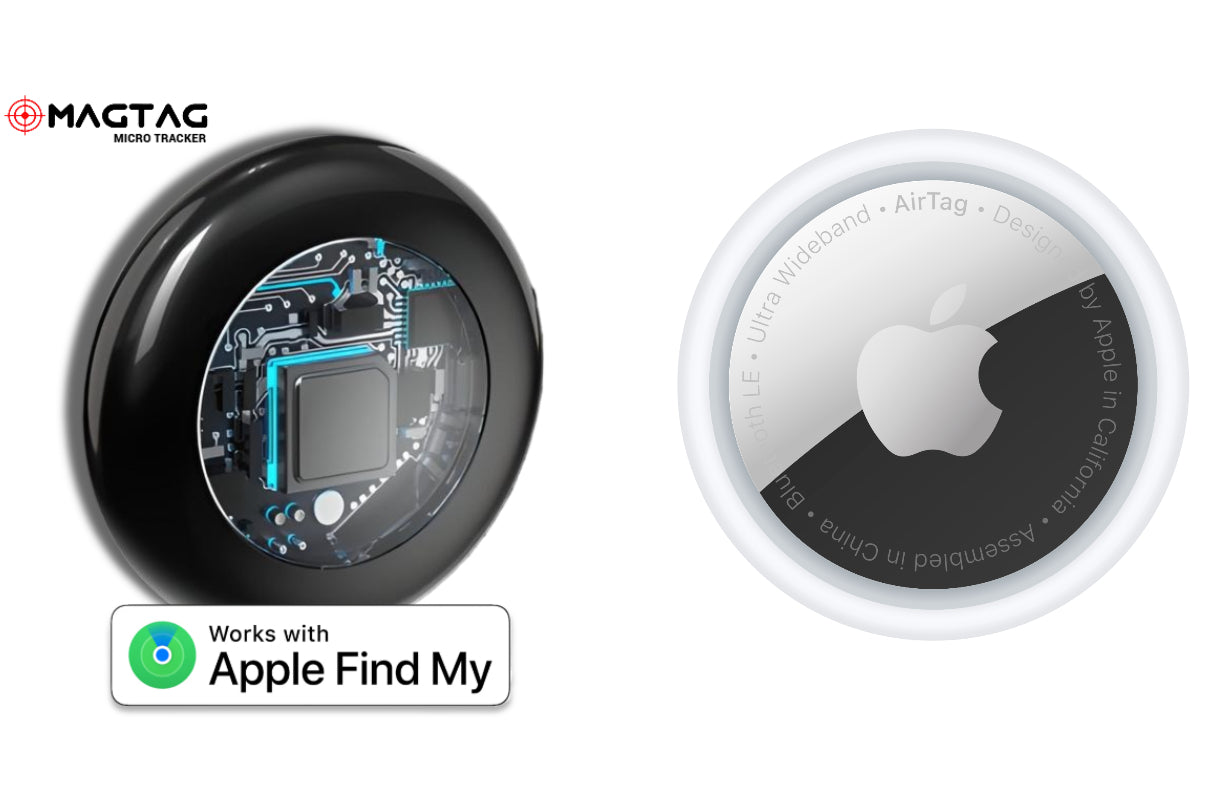With tracking devices becoming essential for safeguarding valuables, choosing the right one matters. Apple’s AirTag is a popular pick for small personal items, but for larger assets, MagTag offers a purpose-built solution. Let’s break down the main differences between these two options so you can pick the best tool for your tracking needs.
1. Purpose and Use Cases
AirTag is ideal for everyday personal items like keys, wallets, or purses. Small and lightweight, it fits easily into small spaces and is perfect for items you often misplace, like around the house or in a public area.
MagTag is designed with larger items in mind, like vehicles, trailers, and equipment. Built with durability in mind, it’s excellent for keeping tabs on assets that may be left in locations without regular access to Apple’s network of devices.
2. Technology and Range
Both AirTag and MagTag use Bluetooth Low Energy (BLE) to communicate with nearby Apple devices and relay location information to Apple’s “Find My” network.
AirTag has an advantage in close-range tracking thanks to Ultra-Wideband (UWB) technology, which provides a more precise location within short distances, especially useful when locating small items in close quarters (like car keys under a couch cushion). While precise for short distances, it is less effective for larger or open areas.
MagTag, though lacking UWB, is optimized for tracking larger assets over long distances. It uses the Apple “Find My” network to relay location data and is designed for cases where pinpoint precision isn’t necessary, like tracking trailers, outdoor gear, or vehicles. This makes MagTag more practical for open, larger environments.
3. Coverage and Range Limitations
GPS technology in GPS trackers provides real-time tracking, as they connect with satellites and use cellular networks. This makes GPS great for tracking assets in remote areas, though it often involves ongoing data and subscription fees.
MagTag leverages Apple’s “Find My” network to relay updates, and is most effective in populated or semi-populated areas with Apple devices nearby. This means it may have limitations in isolated areas, but it still provides a practical solution for urban tracking without the extra costs of GPS data.
4. Battery Life and Maintenance
AirTags have a replaceable CR2032 coin battery, generally lasting around a year with typical use. Replacing the battery is simple, keeping the maintenance minimal.
MagTag also uses a CR2032 battery, which lasts around 6–12 months depending on usage. Both devices are efficient, but MagTag’s low-power design makes it especially well-suited for users who need long-lasting battery life without regular replacements. Both are easily replaceable.
5. Privacy and Anti-Stalking Measures
Apple emphasizes privacy for both AirTag and MagTag devices.
AirTag has built-in anti-stalking features that notify iPhone users if an unknown AirTag has been traveling with them, which helps prevent misuse. However, this also means that a thief with an iPhone may be alerted to the AirTag and disable it before you can recover your item.
MagTag introduces a delayed notification system for potential tracking alerts. This delayed feature is designed to give users more time to locate high-value assets or items in the case of theft, while still meeting Apple’s anti-stalking standards.
This means MagTag can be especially effective for tracking assets at risk of theft. Unlike AirTag’s quick notification system, MagTag’s delayed alert feature gives you an opportunity to act without immediately alerting a potential thief. If your trailer, vehicle, or equipment were to be stolen, for instance, the delayed notification buys you a critical window of time to arrange police recovery without tipping off the thief, making it a more reliable choice for assets in high-risk situations.
6. Durability and Environmental Resistance
While AirTag is water and dust-resistant (IP67), it’s generally designed for personal indoor items. It may not withstand prolonged exposure to outdoor environments.
MagTag offers additional ruggedness with weatherproof casing options, making it a great choice for more extreme conditions. With accessories designed for outdoor use, like weatherproof or magnetic cases, MagTag is ideal for those wanting to track assets left outdoors—whether it’s on a vehicle, boat, or equipment.
7. Cost Comparison
In Australia, AirTags are priced at $49 AUD per unit, while MagTag is priced at $29 AUD, making MagTag the more affordable choice.
Both devices avoid ongoing subscription costs by using Apple’s “Find My” network. However, for those tracking valuable assets or multiple items, MagTag offers a cost-effective option for securing more expensive or hard-to-replace equipment without high upfront or monthly expenses.
Conclusion: Which One Is Right for You?
If your needs are focused on tracking smaller, everyday items, like keys or bags, AirTag is a solid, reliable choice that offers precise location finding in close quarters. However, if you’re looking to protect larger assets or high-value equipment, MagTag provides a robust and cost-effective solution that’s ideal for outdoor use, asset tracking, and theft recovery without tipping off a thief.
When it comes to securing valuable items, choosing the right device can make all the difference. AirTag and MagTag both offer great functionality, so it ultimately depends on the items you want to protect and the environment in which they’ll be used.

Child Safety: How MagTag™ Can Help Parents Keep Track of Their Kids
The Science Behind MagTag™: How Bluetooth Asset Tracking Works